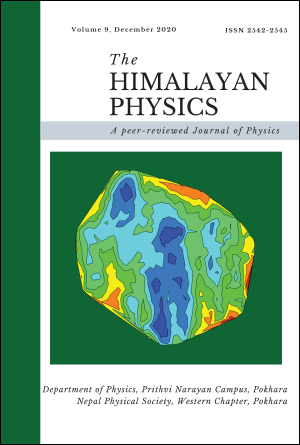Geodynamics of Gorkha earthquake (Mw 7.9) and its aftershocks
DOI:
https://doi.org/10.3126/hp.v9i01.40208Abstract
A devastating earthquake (Mw 7.9) occurred in Gorkha region on 25 April 2015 caused loss of 8964 human lives and huge property in Central Nepal and adjoining region. Sequence of aftershocks, including four having magnitude greater than 6 occurred within 18 days, confined in a distance of about 150 km from Gorkha to Dolakha. Main shock and its aftershocks series confined in a depth range of 12 to 21 km. In this study, using 11 CMT solutions of earthquakes with magnitude 5 and above, occurred between 2014.12.18 and 2016.11.27 within 84o to 87o E and 27o to 29o N, we analyze faulting pattern of the Gorkha earthquake and associated large aftershocks to reveal recent geodynamics pattern in the central Himalayan region. Nodal planes of mainshock and four large aftershocks have east west orientation and shallow dip (6o to 23o) towards north, exhibit strong thrust mechanism. Smaller aftershocks scattered within 150 km long rupture zone along NW to SE direction show similar mechanism with large thrust component. Collective dips of nodal plane of ten events indicate northward under thrusting of the Indian plate at shallow angle, though the nodal plane of individual event differ slightly in their orientation. The cross-sectional study of focal mechanism shows the clustering of the seismic events at different depth with diverse faulting pattern. It is inferred that recent seismic activity in central Nepal region is dominated by thrust faulting and the mechanism which were responsible for the formation of Himalaya are still continuing.
Downloads
Downloads
Published
How to Cite
Issue
Section
License

The articles published in the Himalayan Physics are distributed under a license CC BY-NC-SA 4.0.




